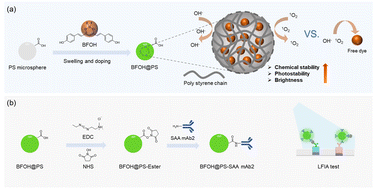Difluoroboron is a fundamental molecular building block that enables the development of numerous highly bright fluorophores for biosensing and imaging. However, its poor stability and limited brightness in aqueous solutions are long-standing and unresolved issues in developing difluoroboron-based fluorophores, which significantly limit their widespread biosensing applicability. Herein, we report a generalizable strategy for synthesising dye-doped fluorescent polystyrene microspheres as a local hydrophobic microenvironment to “protect” difluoroboron curcuminoids from water and reactive oxygen species. This strategy demonstrates a breakthrough in the chemical stability, photo-stability and brightness of difluoroboron-based fluorophores in aqueous solutions, making it suitable for point-of-care testing. The results of lateral flow immunoassay using the dye-doped fluorescent polystyrene microspheres highlight a wide linear range, low limit of detection, good intra-assay and inter-assay coefficient of variations; thus, the reported microspheres can be considered an efficient tool for serum amyloid A detection in human serum samples.
